
16 minute read
Going Global
What you need to know about international shipping
By Brandon Draga, Content Writer at Freightcom
More than ever, we exist in a global market. From large-scale manufacturers to small-scale retailers, business is being conducted from one end of the earth to the other. It only makes sense to consider accessing global marketplaces as a business owner. A recent study by Statista shows that over 50% of all global consumers order products from overseas. In addition, according to DHL, international sales average higher value than domestic sales and can result in 60% faster growth for your business. Navigating international shipping is hardly an easy task. Here we’ll look at some of the finer points of getting your goods anywhere they need to go.
KNOW YOUR MARKET
Like any decision for your business, expanding into the global market is not a decision to make lightly. It is essential to do the proper research to ensure that you expand into markets that will offer a worthwhile ROI. Using website analytics tools is a great way to gain insight into which markets or countries are showing an interest in your business.
Resist the urge to expand too quickly. Focus initially on one or two marketplaces that you can confidently grow into. Studies have shown that many consumer groups will feel more confident purchasing local goods over similar foreign products, so it is essential to research consumer trends to ensure demand for your products.
LEARN THE RULES TO PLAY THE GAME
International shipping laws are constantly changing, so it is worth your time to stay informed of any changes that might impact your chosen global marketplaces. One uncrossed “t” or undotted “i” could mean that your shipment doesn’t ship.
First and foremost, research your destination country’s packaging regulations. As with much international shipping, these regulations can vary from country to country and sometimes from carrier to carrier. For instance, the International Standards for Phytosanitary Measures is a global set of guidelines specifically for using wood as a packaging material for export.
Lastly, but certainly not least, be sure that all your documentation is correct. Typical customs documents include a Commercial Invoice, Export Packing List, and Certificate of Origin.
A Commercial Invoice is used for value appraisal and calculating duties and taxes. It must include retailer name and address; recipient name and address; quantity, description, and price of all items; terms of sale and payment; and mode of transport.
An Export Packing List is similar to a domestic shipment packing list but includes the mode of transport; carrier information; and weight, dimensions, quantity, and type of each package.
A Certificate of Origin lists the country or countries where all products in the shipment were produced, manufactured, and/or obtained. This must be signed by the retailer and occasionally the local chamber of commerce.
When filling out this documentation, be thorough and accurate. In some cases, such as shipping to India, much of this information is required directly on the shipping label. Failure to provide correct information could result in your shipment being delayed or even held.
The result? Fees known as Detention and Demurrage fees. Worse still, these fees are only going up: A report by Container xChange saw the D&D fees across the world increase by an average of 104% in the past year. The more information, the less potential for customs hiccups and unnecessary expenses.
CHOOSE YOUR CARRIER WISELY
Knowing what and where you’re shipping is vital, but knowing who and how is equally important. Choosing the right carrier and method of transport is integral in ensuring that you don’t overpay or underdeliver.
Let’s start with the how; depending on what and where your options for the best means of transport can vary. For instance, shipping by air is undoubtedly the fastest overseas option, but often that speed comes with a premium; air shipping can be three to six times more expensive than sea shipping.
On the other hand, shipping by sea is often a more cost-effective option but is certainly not without drawbacks. Aside from the fact that shipping by sea increases your shipping time by weeks, there is also a higher risk of damaged goods from choppy seas and time in transport, especially for fragile shipments.
Further, it is crucial to keep in mind that different carriers specialize in different shipping forms. The transporter you use to ship a pallet to New York by truck is not likely to be the best choice to air ship a parcel to Beijing. Choosing the right carrier for the job can save you time and money and ensure that your customers have the best experience possible.
Of course, there are other factors to consider when choosing a carrier. For instance, 93% of consumers expect to receive visibility updates on their shipments, so a transporter that offers endto-end tracking on international shipping will be able to keep you and your customers up to date through the whole process. That peace of mind can go a long way in building lasting business relationships.
ARE YOU READY TO GO GLOBAL?
International shipping has become an inescapable reality for nearly every modern business, and with so much to consider when shipping outside your borders, it’s crucial to do it right.
Choose the right market for your business; research your web analytics and consumer trends to ensure a worthwhile ROI.
Be clear on the shipping regulations in Canada and the destination country.
Ensure that all your documentation is thorough and accurate; more information means less potential for error.
Choose the best method for shipping your goods, accounting for time and cost.
Ensure that you also select the best carrier for the job, whichever way you choose. Sourcing your rates from multiple carriers can be too slow, difficult, and time-consuming, so streamline the process by using Freightcom technology that can integrate, consolidate and improve the entire end-to-end shipping process.
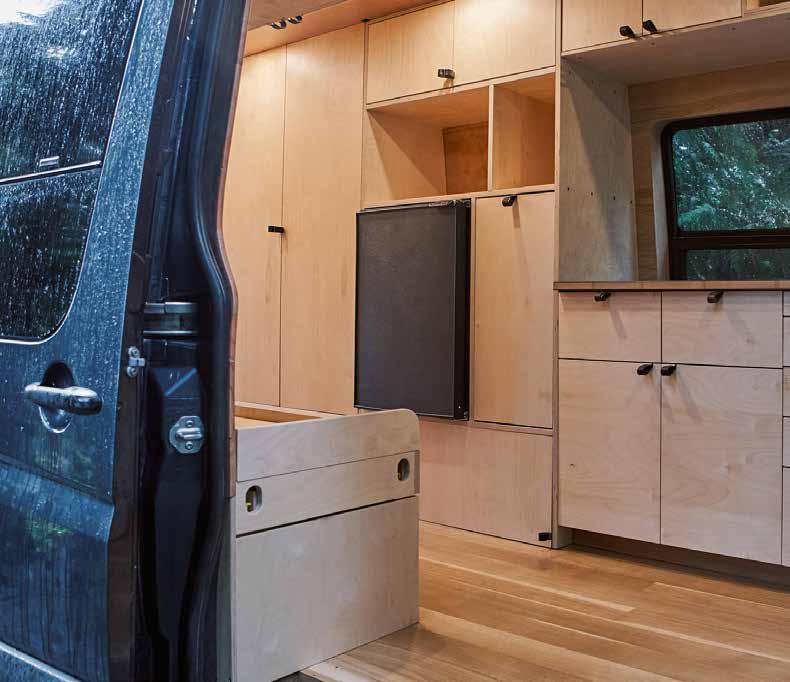
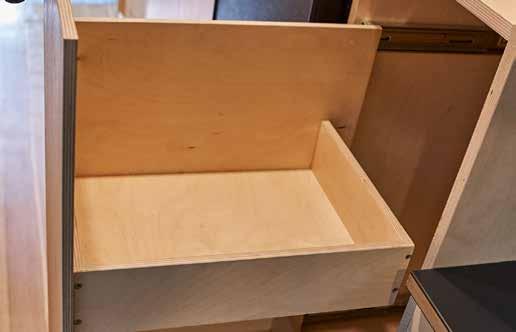
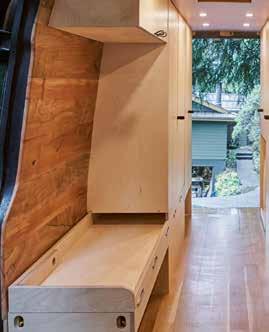
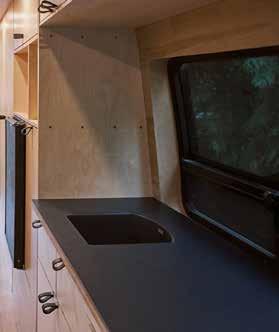
CUSTOM MADE CONCEPTS HITS THE ROAD
By Matthew Bradford, Wood Industry Contributing Writer
From custom vans to million-dollar closets, Chris Relling, owner of Custom Made Concepts, has carved a career out of unique builds.
“I like to say yes to every project,” said Relling. “People ask me, ‘Have you done this before,’ and I say, ‘No, but I know I can, so let’s do this.’ That’s how I’ve gotten the opportunity to work on many unique and cuttingedge projects.”
Relling’s confidence comes from years of practice. That includes growing up in a family where woodworking tools and materials were never far from reach.
“We couldn’t afford things that other people had, but my dad had a workshop, so the first thing we would do if something broke was to try and fix it,” he recalled. “That philosophy stuck with me, and now that I have my own family, I’m still that guy who would rather custom-build something or fix it instead of buying it new.”
A carpenter by trade, Relling started his company out of his home workshop nearly 22 years ago. In the beginning, he focused on building fences, decks, and home renovations. As his reputation grew, he moved into a three-car garage and began tackling custom wood and metal projects.
“About eight years ago, I was working on a project where some guys were doing metalwork on these beau-

Kitchen by Custom Made Concepts
tiful French windows,” he recalled. “I was jealous because it looked like they were having a lot of fun and their work looked amazing, so I went and bought myself a used welding machine to begin trying it out.”
Today, that old, run-down tool has been replaced with more sophisticated machinery, and Relling has turned Custom Made Concepts into a multifaceted builder.
“Now, I come into a project, design a staircase or a railing system, do all of the finishing and trim work that needs to go around it, and see the whole thing come together.”
TAKING THE SHOW ON THE ROAD
A recent van makeover first put Relling on Wood Industry Magazine’s radar. The project included a high-end renovation of a Sprinter van for use by a client hoping to make the most of his retirement.
“I was approached by a man in his sixties planning to travel all over North America in this van. He had hired somebody to do an initial concept of what he wanted and reached out to me for help because he’d seen my millwork and liked what I was doing,” says Relling. “He asked if I would be interested in trying this out, and I said, ‘Yes, of course, I would! This sounds like an amazing opportunity.’”
With the initial concept in hand, Relling’s found a template for the exact model of the van and created a 3D model design. After getting the green
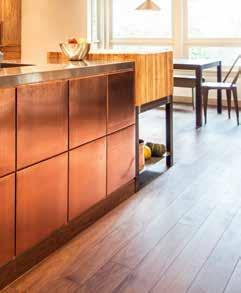

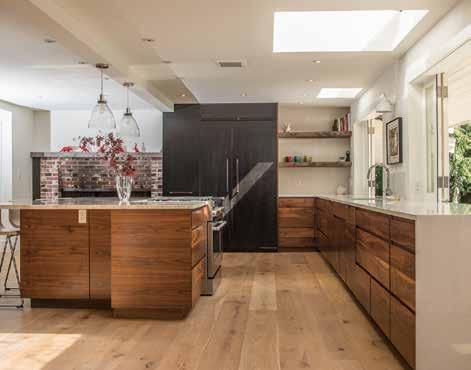
light from the client, he brought the van into his shop and went to work on it for the next two months.
“That was an interesting process,” he recalled. “As a builder, you normally use a level or laser for measurements, but those are completely useless in a van because you can never get it level. So, everything is about reference points, and you’re always measuring off something else, almost like shipbuilding.”
With the details set, Relling installed the rift-cut white oak flooring and began designing and cutting the tailor-made templates. The finished project features rich baltic birch millwork, maple and arbutus door panels, leather pulls, and other roadshowworthy amenities.
A GROWING PORTFOLIO
The custom van is one of many headturning creations in Relling’s portfolio. Past projects have also included fireplaces, board room tables, pool table lights, guitar enclosures, kitchen renos, and more. He also created $400,000 worth of custom millwork for a high-end home walk-in closet and
Kitchens by Custom Made Concepts
spent over two years crafting interior and exterior elements for a multi-million dollar home in North Vancouver.
“I’ve done a lot of beautiful projects, but I’ve never worked on something like that,” he says. “The level that my client took things to was mind-blowing. It was essentially an 8,000 square foot piece of furniture, and it turned out incredible.”
Relling continues to add to his portfolio; the past two years have been amongst his busiest to date.
“As soon as COVID hit, the phone started ringing. I was working from home seven days a week, just cranking stuff out because there were a lot of people stuck at home who wanted to do renovations and home improvements. I don’t think that I took more than ten days during the whole pandemic.”
Relling says his growing portfolio is owed to a modest social media presence, customer word of mouth, and the reputation he’s built among his community.
“I thrive on new challenges. If I have to do something too many times, it gets boring, so it’s fun to switch it up. Being creative and problem-solving is just in my blood. I enjoy building things - it doesn’t matter what the material is; I just love to create.”
Starting August 23, It’s All the New You Need...









MODERN FARMHOUSE KITCHENS
Trendy or timeless?
By Brynley Braam, Marketing Manager at Braam’s Custom Cabinets
Modern farmhouse design has, in recent years, been made popular by HGTV and their TV star Joanna Gaines. And we can see why. Modern farmhouse combines rustic design components with clean lines and neutral tones — taking the best of sleek modern and mixing it with homey farmhouse vibes. Ava, a cabinet designer out of our London, Ontario showroom, describes this contemporary-meets-traditional style:
“Modern Farmhouse is a more refined elegant style with simplified lines and warm, cozy finishes for a timeless, comfortable look.”
While modern farmhouse designs might be having a moment, that doesn’t mean that this style will become obsolete. Instead of choosing the in-the-moment colours and materials, go for options that have always been fashionable, like neutrals, palatable woods, and timeless hardware.
WHO SHOULD CONSIDER A MODERN FARMHOUSE STYLE
The modern farmhouse is a healthy mix of traditional and contemporary. We suggest exploring this style with clients who love classic and more current interiors. As Heather, a Braam’s designer from our Birmingham, Michigan location, explains:
“Modern farmhouse design is a blend of old school treasures with new school design. Think modern elements like smooth lines and polished accents blended with natural elements. Modern farmhouse is less rustic and more refined than the classic farmhouse design.”
The stunning combination of two contrasting styles is a win for anyone that can’t see their homes without a touch of both spirits. You get the best of each world: the warmth of traditional details and the structure of modern elements. What you’re left
White modern farmhouse with blue island by Braam’s Custom Cabinets
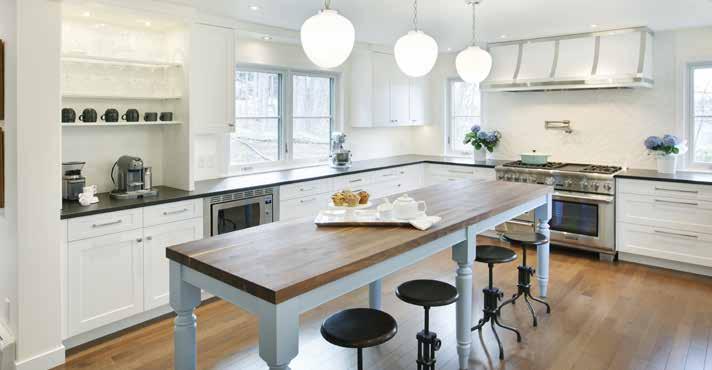
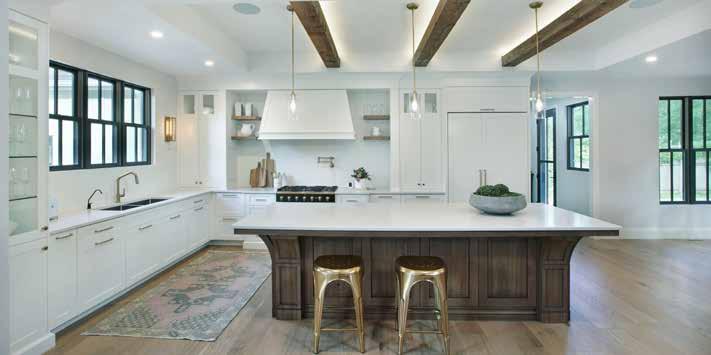
TOP: White and wood modern farmhouse by Braam’s Custom Cabinets BOTTOM: White modern contemporary farmhouse by Braam’s Custom Cabinet
with is a beautiful interior with details that contemporary admirers and classic lovers will have something to appreciate.
However, we know that some people have valid concerns. Is this contemporary farmhouse interior style something of a trend? Or is it timeless? We like to think of it as the latter. As Ava tells us:
“I think done the right way, it is very timeless. Avoiding trendy colours, tiles and countertops is key.”
HOW TO DESIGN A MODERN FARMHOUSE KITCHEN
So you’ve talked your customer into a modern farmhouse kitchen, bathroom, office, or library. We have a few tips to help you on your way, as Ava and Heather advise: • Typical cabinet colours for modern farmhouse design would be a soft white (like Chantilly lace) or a classic grey. We like white oak in a bleached stain if the customer is looking for wood. We love two-tone modern farmhouse kitchens with a wood island! • If they’re feeling adventurous, a gorgeous navy or even black statement piece makes for a bold space. • Opt for light colours for countertops.
We prefer quartzite and marble. • Choose simple hardware pieces like long pulls or even smaller latches in honey bronze or ash grey finishes.
Modest, uncomplicated hardware is key for this style.
Overall, you can make this design style fit any home. As Ava points out:
“My advice to any client is always to choose the style that suits their taste and makes them feel right at home.”
STAY WITH THE TIMES WITHOUT GIVING INTO A TREND
Modern farmhouse design is a great way to stay relevant within the design realm without sacrificing traditional taste. Interpretation within this particular style is up to the homeowner. Remind customers that they have the freedom to incorporate as many modern or traditional elements as they see fit, making their unique version of the modern farmhouse style, only including the aspects they enjoy.
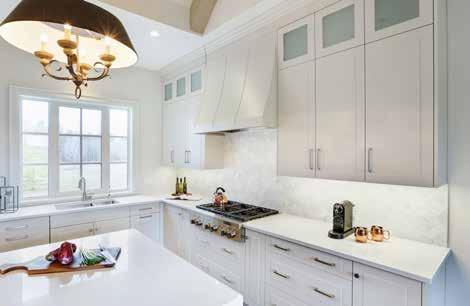
RETIREMENT AND AUTOMATION
By Grace Tatigian

Many have all been blaming the labour shortage on the pandemic, some saying that “no one wants to work anymore” and complaining that CERB and other government supports have made workers lazy. However, statistics show that labour force growth was slowing long before we were hit with COVID-19; between retiring Baby Boomers and young workers taking longer to complete their post-secondary education, there are more vacancies than candidates to fill them. This has actually been the case for the last 20 years. The pandemic was just the straw that broke the camel’s back.
Statistics Canada’s Labour Force Survey shows that retirements are expected to remain high until at least 2026, so employers need to give up the idea that the labour shortage is a shortterm problem that will disappear when COVID ends. Overall, 55% of Canadian employers are struggling to hire workers. The manufacturing sector has been particularly hard hit, with Canadian Manufacturers & Exporters estimating 65,000 job vacancies across the country.
So how can employers, and more specifically manufacturers, adapt?
One of the most impactful changes that manufacturers can make is increasing automation. The Business Development Bank of Canada’s How to Adapt to the Labour Shortage Situation report for BDC pointed out that 53% of manufacturing businesses with new technology and automation found it easy to hire employees. In comparison, only 25% of manufacturing companies without new tech and automation found it easy. Of course, integrating automation is no small feat.
The report indicates that the high upfront cost is the biggest roadblock for SMEs that have automated their processes. When a business has been dealing with the difficulties of the labour shortage for years, reducing their capacity for growth (64%) and facing order delays (44%), it can be hard to earmark a hefty sum for new technology. But if you don’t have the staff, you can’t complete the work. So if you can’t get the people, you need technology. Once you have the machines, it will be easier to hire more people, meaning you can take on more projects. The report states that companies that integrate automation are almost twice as likely to see sales growth above the industry average than companies that have not automated.
It’s all circular.
Investing in the right technology is an investment in your team. For employers who’ve faced difficulty with hiring, 61% have had to increase their employees’ hours — leading to burnout - and 49% have needed to increase wages and benefits to help with retention. As Gen Z leaves trade school and enters the workforce, they’re going to know how to operate this kind of technology and look for a job where they can put these skills to good use. Unsurprisingly, most prefer skilled work to manual labour.
The idea that robots make workers redundant is outdated. Let the robots do the heavy lifting to you can hire skilled, hard-working tradespeople and give them a job that they will enjoy long-term.






